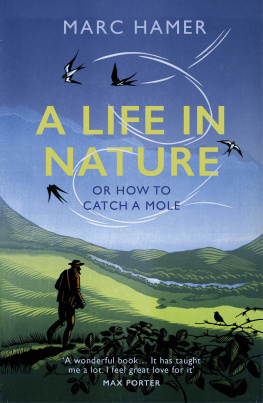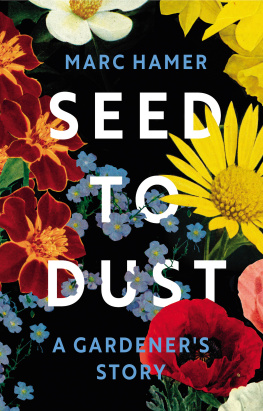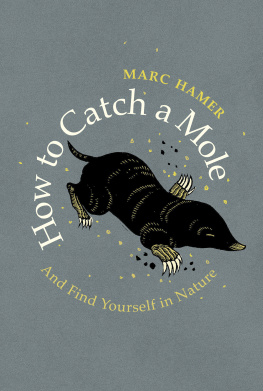Marc Hamer - A Life in Nature: Or How to Catch a Mole
Here you can read online Marc Hamer - A Life in Nature: Or How to Catch a Mole full text of the book (entire story) in english for free. Download pdf and epub, get meaning, cover and reviews about this ebook. year: 2019, publisher: Random House, genre: Art. Description of the work, (preface) as well as reviews are available. Best literature library LitArk.com created for fans of good reading and offers a wide selection of genres:
Romance novel
Science fiction
Adventure
Detective
Science
History
Home and family
Prose
Art
Politics
Computer
Non-fiction
Religion
Business
Children
Humor
Choose a favorite category and find really read worthwhile books. Enjoy immersion in the world of imagination, feel the emotions of the characters or learn something new for yourself, make an fascinating discovery.
- Book:A Life in Nature: Or How to Catch a Mole
- Author:
- Publisher:Random House
- Genre:
- Year:2019
- Rating:5 / 5
- Favourites:Add to favourites
- Your mark:
- 100
- 1
- 2
- 3
- 4
- 5
A Life in Nature: Or How to Catch a Mole: summary, description and annotation
We offer to read an annotation, description, summary or preface (depends on what the author of the book "A Life in Nature: Or How to Catch a Mole" wrote himself). If you haven't found the necessary information about the book — write in the comments, we will try to find it.
A Life in Nature: Or How to Catch a Mole — read online for free the complete book (whole text) full work
Below is the text of the book, divided by pages. System saving the place of the last page read, allows you to conveniently read the book "A Life in Nature: Or How to Catch a Mole" online for free, without having to search again every time where you left off. Put a bookmark, and you can go to the page where you finished reading at any time.
Font size:
Interval:
Bookmark:



Marc Hamer was born in the North of England and moved to Wales over thirty years ago. After spending a period homeless, then working on the railway, he returned to education and studied fine art in Manchester and Stoke-on-Trent. He has worked in art galleries, marketing, graphic design, as a magazine editor and taught creative writing in a prison before becoming a gardener. A Life in Nature, his first book, was longlisted for the Wainwright Prize.
For Kate
(Peggy)
To whom I owe everything

As You Like It, Act III, Scene 2
Robbie Burns

I am a gardener. I have been catching moles in gardens and farms for years, and I have decided that I am not going to do it any more. Molecatching is a traditional skill that has given me a good life, but I am old now and tired of hunting, trapping and killing, and it has taught me what I needed to learn.
To protect their livelihood, molecatchers have always kept their knowledge hidden. I dont want to let that tradition disappear, so in this book I am going tell you about the behaviour of moles and how to catch them, should you want to do so, and a little about what you can do instead. Wrapped around this tradition is the story of the mole itself, and also of my life as a molecatcher: what that life was like, the long route to getting there, how it affected me, and why eventually I decided to stop.
I feel some conflict about stopping. To the core of my being I love the life that I have been given. A life that encourages a passion for nature, for its functional beauty and its violent brutal energy even for its decay. It has been a reflective life that has affected my view of the wider world and how to live in it. It changed my relationship with myself, with my personal history and with my family. So here there are fragments of my life, too, and some of the things that led me to becoming a molecatcher.
Each telling of any story seems different, and this is true of my own life. When I was sixteen I left home and started walking. I walked for about eighteen months, and lived wild with the animals and birds, sleeping under hedges, in woodlands and on riverbanks. I will try to be as truthful as possible about this too, but not all the facts are clear. There is much that I cant remember. Sometimes the two stories of mole and me seem to be inextricably intertwined. There are echoes and reflections. But the dance between these two vague tales has become a way of living that I find simple and beautiful and has given me everything that I could ever want.
I wonder about truth and what it is as I chase it around and play with it. Recollections rarely come in chronological order. Memory wanders in the darkness, and the harder I try to remember, the more it seems to dissolve in front of me and take a different direction. As soon as I start to examine a story with anything more intense than a sidelong glance, it shifts in reaction to the scrutiny, reconstructs itself and then changes again, like looking into a kaleidoscope: the colours are identical, their patterns slightly different every time, their detail constantly changes yet the picture remains true to itself.
All the facts that I recall easily are just high points and low ones, bits remembered only because they have some emotional impact or connection to something seen or remembered. They are like a string of pearls: tarnished pearls that have been shut in a drawer and rarely taken out. As I pull them out and look at them some of them are missing, and life seems like mostly string without a pearl in sight and then a cluster of them appear, tangled and out of sequence. There is no certainty there, and yet, I will try to unravel the strands.
Often I do not disturb myself with language and I just look and enjoy. At other times words come silently creeping in on insect legs. Some start to build a nest, develop a theme a twig here, a bud there so I let them. I like to write bits, tiny bits of stuff that fly by like leaves, insubstantial, scattering, and could be gone if I didnt grab them out of the air. Bits of ordinary stuff that I see and that I can hold in my head in their entirety. Like individual memories or the fragments of pottery that I find in the molehills. Here alongside and flowing sometimes in and around the simple yet often bizarre facts about how to catch a mole are these fragments, sometimes sharp, sometimes smooth, written for the most part while wandering across a field with a bag of traps.
Telling the whole story of the life of a mole is equally impossible. Hidden in the darkness, his story is created from myths and a handful of observations passed on from person to person, each with their own point of view. The moles, like us, are deeply mysterious creatures, and we will only ever catch a glimpse of their truth.
What things seem to be matters far more to me than what things actually are. What they actually are is unknowable. I dont like that prison of hard and cold facts. Facts do not set you free, they trap you into a constructed view of reality that is final. The only truth is here, and here, and here in the three seconds before it becomes a reconstruction. Really I want to forget. Forgetting is freedom and forgiveness but more than anything it is a process of immersing myself in what is happening now.
I could tell this story with myself as the villain or the hero, innocent bystander or agent provocateur, and each time Id be telling a form of the truth. What is the value of a truth that has an infinite number of forms? There is a difference between truth and honesty, so I am going to tell you one of the millions of honest stories that I could tell you that might be good enough to call true. One of the stories that led me to the point of kneeling in a muddy field in December with a dead mole in my hand and deciding it was time to stop killing.
How to catch a mole, life as a molecatcher. Written in the season of catching moles, instead of catching moles. I think the only certainty I can give you about this book is that by the end you will know a lot more about moles.
As I sit here writing at my kitchen table, a ladybird is crawling on my leg. I accidentally bring a lot of wildlife home from work. Beetles and spiders, the occasional grasshopper under my collar, ants in the creases of my work trousers or fallen into my boots.
Next pageFont size:
Interval:
Bookmark:
Similar books «A Life in Nature: Or How to Catch a Mole»
Look at similar books to A Life in Nature: Or How to Catch a Mole. We have selected literature similar in name and meaning in the hope of providing readers with more options to find new, interesting, not yet read works.
Discussion, reviews of the book A Life in Nature: Or How to Catch a Mole and just readers' own opinions. Leave your comments, write what you think about the work, its meaning or the main characters. Specify what exactly you liked and what you didn't like, and why you think so.












